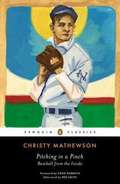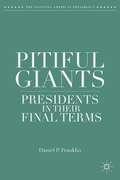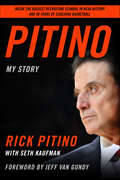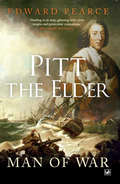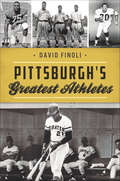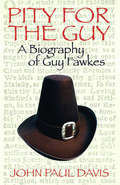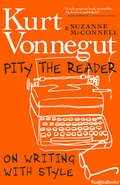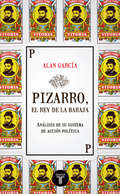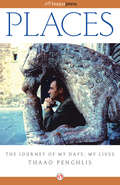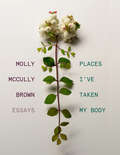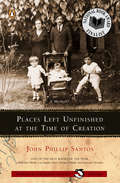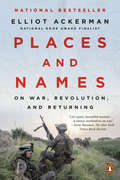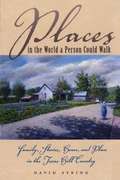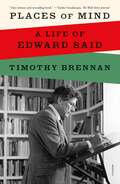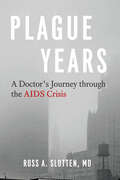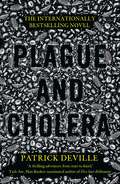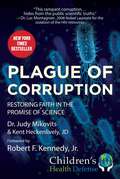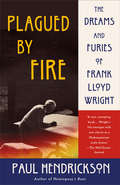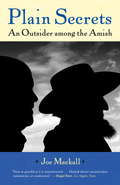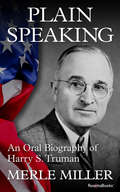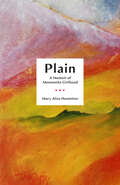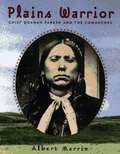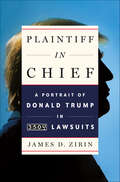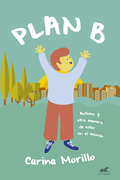- Table View
- List View
Pitching in a Pinch: Baseball from the Inside
by Red Smith Chad Harbach Christy MathewsonAn inside baseball memoir from the game’s first superstar, with a foreword by Chad Harbach Christy Mathewson was one of the most dominant pitchers ever to play baseball. Posthumously inducted into the Baseball Hall of Fame as one of the "Five Immortals,” he was an unstoppable force on the mound, winning at least twenty-two games for twelve straight seasons and pitching three complete-game shutouts in the 1905 World Series. Pitching in a Pinch, his witty and digestible book of baseball insights, stories, and wisdom, was first published over a hundred years ago and presents readers with Mathewson’s plainspoken perspective on the diamond of yore-on the players, the chances they took, the jinxes they believed in, and, most of all, their love of the game. Baseball fans will love to read first-hand accounts of the infamous Merkle’s Boner incident, Giants manager John McGraw, and the unstoppable Johnny Evers and to learn how much-and just how little-has really changed in a hundred years. .
Pitiful Giants
by Daniel P. FranklinSince ratification of the 22nd Amendment in 1951, five American presidents Eisenhower, Reagan, Clinton, Bush, and Obama have been elected to serve a second term. Presumably, by virtue of their term-limited status, these presidents are free from electoral pressure to pursue policies in the public interest, but this is a questionable assumption. Second term presidents face a host of structural obstacles that make it difficult for them to carry out their tasks. How then do presidents lead through these politically-complex circumstances? How can presidents make the most of their second-tem "mandates" while battling against waning political power? This book seeks to answer the complex and often paradoxical challenges presidents encounter in their lame duck years. "
Pitino: My Story
by Rick Pitino Seth KaufmanOn September 26, 2017, the biggest recruiting scandal in college basketball history sent shock waves through the world of sports. Caught up in a massive FBI and NCAA investigation—and the intense media spotlight—was Rick Pitino, the Louisville Cardinals’ Hall of Fame coach. Here, from Pitino himself, comes the real story of the ongoing case and the hard truth about how college hoops has been pushed to the brink of disaster by greed, bad actors, and shoe company money. Rick Pitino has spent a lifetime in basketball. He is the recruiting and coaching maestro behind Final Four appearances with three different teams, and National Championships at two of them. He worked the early days of the legendary Five-Star camp and scouted players without the influence of agents, runners, or shoe companies. And he has run today’s recruiting gauntlet of sports apparel marketing, corrupted assistant coaches, unethical youth coaches, and powerful organizations hellbent against him. Rick Pitino has seen it all, dealt with it all, and now tells it all.Pitino is the story of an epic coaching career and the evolution of NCAA basketball to the multi-billion-dollar enterprise it is today. It is also a master’s course on the arts of coaching and recruiting. And in the telling, the one and only Rick Pitino lays all his cards on the table in addressing scandals of his past and the current headline-grabbing investigation that led a packed Board of Directors at Louisville to derail his career.
Pitt the Elder: Man of War
by Edward PearceThis remarkable book opens at the dawn of the British Empire - with the great sea battle at Quiberon Bay where French ships, intended for the 1759 invasion of Britain, are chased, caught and defeated by a fleet commanded by Admiral Sir Edward Hawke. In this momentous victory Britain effectively settled the outcome of the Seven Years' War and established itself as the world's dominant imperial power.At the heart of the conflict with France was William Pitt, the first Earl of Chatham and Britain's future Prime Minister. Weaving together military history and political biography Edward Pearce provides a portrait of the man 'with an eye like a diamond' - a man who had close ties with the slave trade and who preached war and British supremacy on a world stage. Alongside detailed descriptions of battles in Europe and North America we follow Pitt's career as a politician - one that was closely intertwined with General James Wolfe at Quebec; American independence; the slow mind of George III and the quick one of the rake and outsider John Wilkes.Edward Pearce scrutinises the real man at the heart of the historical events and mystique surrounding the legacy of Pitt the Elder, to present a rounded and masterful portrait of arguably the most powerful minister ever to guide Britain's foreign policy and of an age which marked a new epoch in history, when the balance of power in Europe and the world was set for almost two centuries.
Pittsburgh's Greatest Athletes: A Decidedly Subjective Ranking Of The Greatest Athletes To Ever Play On Pittsburgh's Diamonds, Gridirons, Rinks, Rings, Courts, Tracks And More (Sports)
by David FinoliAuthor and sports historian David Finoli's inside look at the 50 greatest male and female athletes in Pittsburgh history.Greatness in sport is both undefinable and immediately recognizable. Though it is rare, Western Pennsylvania has been graced with a long history of athletes who embody the essence of greatness. They have proudly represented the region in sports such as boxing, golf and track; carried their collegiate teams to victory; and worn the black and gold of the Steelers, Pirates and Penguins. Pittsburghers still recall how Mario Lemieux glided effortlessly through an opposing defense before befuddling the goalie or Arnold Palmer's unique swing that made the everyday duffer feel like he was one of them. Fans debate whether Terry Bradshaw or Ben Roethlisberger is the better quarterback and what the legacy of Barry Bonds is, while keeping Roberto Clemente among their most cherished icons. Take a deep dive into all of that and more and re-discover the best of the best in Pittsburgh sports history.
Pity for The Guy: A Biography of Guy Fawkes
by John Paul DavisThe first fully-rounded portrait of the man behind the Gunpowder Plot For hundreds of years Guy Fawkes has been portrayed as perhaps too extreme a figure--a rabid, bloodthirsty Catholic who not only tried to bomb British Parliament but threatened the English way of life. This biography reveals that he was much more than an evil, shadowy conspirator with an axe to grind. John Paul Davis delves into the evidence and makes a convincing case for new thinking on one of English history's greatest enigmas. Not only is the Gunpowder Plot of 1605 thrillingly reteold, but Guy Fawkes can now be seen as a multi-faceted figure--husband, soldier, lover, adveturer, spy, and possibly the most misunderstood of English villains.
Pity the Reader: On Writing with Style
by Kurt Vonnegut Jr. Suzanne McConnell&“A rich, generous book about writing and reading and Kurt Vonnegut as writer, teacher, and friend . . . Every page brings pleasure and insight.&”—Gail Godwin, New York Times bestselling author Here is an entirely new side of Kurt Vonnegut, Vonnegut as a teacher of writing. Of course he&’s given us glimpses before, with aphorisms and short essays and articles and in his speeches. But never before has an entire book been devoted to Kurt Vonnegut the teacher. Here is pretty much everything Vonnegut ever said or wrote having to do with the writing art and craft, altogether a healing, a nourishing expedition. His former student, Suzanne McConnell, has outfitted us for the journey, and in these 37 chapters covers the waterfront of how one American writer brought himself to the pinnacle of the writing art, and we can all benefit as a result. Kurt Vonnegut was one of the few grandmasters of American literature, whose novels continue to influence new generations about the ways in which our imaginations can help us to live. Few aspects of his contribution have not been plumbed—fourteen novels, collections of his speeches, his essays, his letters, his plays—so this fresh view of him is a bonanza for writers and readers and Vonnegut fans everywhere. &“Part homage, part memoir, and a 100% guide to making art with words, Pity the Reader: On Writing with Style is a simply mesmerizing book, and I cannot recommend it highly enough!&”—Andre Dubus III, #1 New York Times bestselling author &“The blend of memory, fact, keen observation, spellbinding descriptiveness and zany characters that populated Vonnegut&’s work is on full display here.&”—James McBride, National Book Award-winning author
Pizarro, el rey de la baraja.: Análisis de su sistema de acción política
by Alan GarcíaUna lección de política a través del estudio de uno de los principales conquistadores de América: Francisco Pizarro.Francisco Pizarro es una figura extensamente estudiada por historiadores, escritores y autores de las más diversas orientaciones, quienes durante casi 500 años se han preguntado cómo un aventurero español, a la cabeza de un reducido ejército, logró conquistar el Imperio Inca. En este libro, sin embargo, el ex presidente peruano Alan García desarrolla un análisis novedoso, desde un ángulo muy pocas veces abordado: Pizarro como personaje político. García explora de forma rigurosa los hechos históricos y extrae de ellos las reglas o normas políticas que guiaron los actos de Pizarro hacia el éxito en la conquista de unos de los mayores imperios de la América prehispánica.Pizarro no fue un ajedrecista al modo de Napoleón, pero fue un espléndido jugador de naipes. A partir de este hecho, Alan García elabora una comparación metafórica entre la política y el juego de cartas, para analizar el papel que el azar y el cálculo juegan en cada caso. Tal y como sucede en la baraja que, en principio, está regida por la suerte o la providencia, también las acciones de Pizarro estaban condicionadas por un contexto específico poco favorable; sin embargo, es ahí donde interviene la astucia del conquistador y del jugador de naipes: cuando vence la adversidad con inteligencia y construye infinitas posibilidades.Pizarro, el Rey de la Baraja, combina el análisis y conocimiento detallado de la historia con la agilidad de la prosa. Y más allá de su carácter histórico, nos brinda una comprensión de la política y el liderazgo, válida para los tiempos actuales.
Places
by Thaao PenghlisThaao Penghlis enjoyed tea for two with Jacqueline Kennedy Onassis and fitted Robert Redford for a suit--suggesting that the then-matinee idol shed a few pounds--before landing career-defining roles on General Hospital and Days of Our Lives. He pursued a career as an actor to fund his unyielding desire for spiritual and exotic travel and became one of daytime television's most enduring characters on Days of Our Lives. His memoir weaves his deep Greek and Australian heritage with Hollywood escapades and captivating journeys to places few visit.
Places I've Taken My Body: Essays
by Molly McCully BrownIndispensable essays on the body, mind, and spirit by Molly McCully Brown, author of the acclaimed poetry collection, The Virginia State Colony for Epileptics and Feebleminded, a book the New York Times described as “part history lesson, part séance, part ode to dread. It arrives as if clutching a spray of dead flowers. It is beautiful and devastating.” In seventeen intimate essays, poet Molly McCully Brown explores living within and beyond the limits of a body—in her case, one shaped since birth by cerebral palsy, a permanent and often painful movement disorder. In spite of—indeed, in response to—physical constraints, Brown leads a peripatetic life: the essays comprise a vivid travelogue set throughout the United States and Europe, ranging from the rural American South of her childhood to the cobblestoned streets of Bologna, Italy. Moving between these locales and others, Brown constellates the subjects that define her inside and out: a disabled and conspicuous body, a religious conversion, a missing twin, a life in poetry. As she does, she depicts vividly for us not only her own life but a striking array of sites and topics, among them Mary Shelley’s Frankenstein and the world’s oldest anatomical theater, the American Eugenics movement, and Jerry Falwell’s Liberty University. Throughout, Brown offers us the gift of her exquisite sentences, woven together in consideration, always, of what it means to be human—flawed, potent, feeling.
Places Left Unfinished at the Time of Creation
by Santos John PhillipFinalist for the National Book Award! In this beautifully wrought memoir, award-winning writer John Philip Santos weaves together dream fragments, family remembrances, and Chicano mythology, reaching back into time and place to blend the story of one Mexican family with the soul of an entire people. The story unfolds through a pageant of unforgettable family figures: from Madrina--touched with epilepsy and prophecy ever since, as a girl, she saw a dying soul leave its body--to Teofilo, who was kidnapped as an infant and raised by the Kikapu Indians of Northern Mexico. At the heart of the book is Santos' search for the meaning of his grandfather's suicide in San Antonio, Texas, in 1939. Part treasury of the elders, part elegy, part personal odyssey, this is an immigration tale and a haunting family story that offers a rich, magical view of Mexican-American culture. .
Places and Names: On War, Revolution, and Returning
by Elliot AckermanFrom a decorated Marine war veteran and National Book Award Finalist, an astonishing reckoning with the nature of combat and the human cost of the wars in Iraq, Afghanistan and Syria. <P><P>"War hath determined us ..." - John Milton, Paradise Lost <P><P>Toward the beginning of Places and Names, Elliot Ackerman sits in a refugee camp in southern Turkey, across the table from a man named Abu Hassar, who fought for Al Qaeda in Iraq, and whose connections to the Islamic State are murky. At first, Ackerman pretends to have been a journalist during the Iraq War, but after establishes a rapport with Abu Hassar, he takes a risk by revealing to him that in fact he was a Marine special operation officer. <P><P>Ackerman then draws the shape of the Euphrates River on a large piece of paper, and his one-time adversary quickly joins him in the game of filling in the map with the names and dates of where they saw fighting during the war. They had shadowed each other for some time, it turned out, a realization that brought them to a strange kind of intimacy. <P><P>The rest of Elliot Ackerman's extraordinary memoir is in a way an answer to the question of why he came to that refugee camp and what he hoped to find there. By moving back and forth between his recent experiences on the ground as a journalist in Syria and its environs and his deeper past in combat in Iraq and Afghanistan, he creates a work of astonishing atmospheric pressurization. <P><P>Ackerman shares extraordinarily vivid and powerful stories of his own experiences in battle, culminating in the events of the Second Battle of Fallujah, the most intense urban combat for the Marines since Hue in Vietnam, where Ackerman's actions leading a rifle platoon saw him awarded the Silver Star. He weaves these stories into the latticework of a masterful larger reckoning, with contemporary geopolitics through his vantage as a journalist in Istanbul and with the human extremes of both bravery and horror. <P><P> At once an intensely personal book about the terrible lure of combat and a brilliant meditation on the larger meaning of the past two decades of strife for America, the region and the world, Places and Names bids fair to take its place among our greatest books about modern war.
Places in the World a Person Could Walk: Family, Stories, Home, and Place in the Texas Hill Country
by David SyringSpring-fed creeks. Old stone houses. Cedar brakes and bleached limestone. The Hill Country holds powerful sway over the imagination of Texans. So many of us dream of having our own little place in the limestone hills. The Hill Country feels just like home, even if you've never lived there. <p><p> This beautifully written book explores what the Hill Country has meant as a homeplace to the author, his family, and longtime residents of the area, as well as to newcomers. David Syring listens to the stories that his aunts, uncles, and cousins tell about life in the Hill Country and grapples with their meaning for his own search for a place to belong. He also collects short stories focused around Honey Creek Church to consider how places become containers for memory. And he draws upon several years of living in Fredericksburg to talk about the problems and opportunities created by heritage tourism and the development of the town as a "home" for German Americans. These interconnected stories illuminate what it means to belong to a place and why the Texas Hill Country has become the spiritual, if not actual, home of many people.
Places of Mind: A Life of Edward Said
by Timothy BrennanOne of The New York Times's books to watch for in MarchThe first comprehensive biography of the most influential, controversial, and celebrated Palestinian intellectual of the twentieth centuryAs someone who studied under Edward Said and remained a friend until his death in 2003, Timothy Brennan had unprecedented access to his thesis adviser’s ideas and legacy. In this authoritative work, Said, the pioneer of postcolonial studies, a tireless champion for his native Palestine, and an erudite literary critic, emerges as a self-doubting, tender, eloquent advocate of literature’s dramatic effects on politics and civic life.Charting the intertwined routes of Said’s intellectual development, Places of Mind reveals him as a study in opposites: a cajoler and strategist, a New York intellectual with a foot in Beirut, an orchestra impresario in Weimar and Ramallah, a raconteur on national television, a Palestinian negotiator at the State Department, and an actor in films in which he played himself. Brennan traces the Arab influences on Said’s thinking along with his tutelage under Lebanese statesmen, off-beat modernist auteurs, and New York literati, as Said grew into a scholar whose influential writings changed the face of university life forever. With both intimidating brilliance and charm, Said melded these resources into a groundbreaking and influential countertradition of radical humanism, set against the backdrop of techno-scientific dominance and religious war. With unparalleled clarity, Said gave the humanities a new authority in the age of Reaganism, one that continues today.Drawing on the testimonies of family, friends, students, and antagonists alike, and aided by FBI files, unpublished writings, and Said's drafts of novels and personal letters, Places of Mind synthesizes Said’s intellectual breadth and influence into an unprecedented, intimate, and compelling portrait of one of the great minds of the twentieth century.
Plague Years: A Doctor’s Journey through the AIDS Crisis
by Ross A. Slotten, MDIn 1992, Dr. Ross A. Slotten signed more death certificates in Chicago—and, by inference, the state of Illinois—than anyone else. As a family physician, he was trained to care for patients from birth to death, but when he completed his residency in 1984, he had no idea that many of his future patients would be cut down in the prime of their lives. Among those patients were friends, colleagues, and lovers, shunned by most of the medical community because they were gay and HIV positive. Slotten wasn’t an infectious disease specialist, but because of his unique position as both a gay man and a young physician, he became an unlikely pioneer, swept up in one of the worst epidemics in modern history. Plague Years is an unprecedented first-person account of that epidemic, spanning not just the city of Chicago but four continents as well. Slotten provides an intimate yet comprehensive view of the disease’s spread alongside heartfelt portraits of his patients and his own conflicted feelings as a medical professional, drawn from more than thirty years of personal notebooks. In telling the story of someone who was as much a potential patient as a doctor, Plague Years sheds light on the darkest hours in the history of the LGBT community in ways that no previous medical memoir has.
Plague and Cholera
by Patrick DevilleParis, May 1940. Nazi troops storm the city and at Le Bourget airport, on the last flight out, sits Dr Alexandre Yersin, his gaze politely turned away from his fellow passengers with their jewels sewn into their luggage. He is too old for the combat ahead, and besides he has already saved millions of lives. When he was the brilliant young protégé of Louis Pasteur, he focused his exceptional mind on a great medical conundrum: in 1894, on a Hong Kong hospital forecourt, he identified and vaccinated against bubonic plague, later named in his honour Yersinia pestis.Swiss by birth and trained in Germany and France, Yersin is the son of empiricism and endeavour; but he has a romantic hunger for adventure, fuelled by tales of Livingstone and Conrad, and sets sail for Asia. A true traveller of the century, he wishes to comprehend the universe. Medicine, agriculture, the engine of the new automobile, all must be opened up, examined and improved. Ceaselessly curious and courageous, Yersin stands, a lone genius,against a backdrop of world wars, pandemics, colonialism, progress and decadence. He is brought to vivid, thrilling life in Patrick Deville's captivating novel, which was a bestseller and shortlisted for every major literary award in France.
Plague of Corruption: Restoring Faith in the Promise of Science (Children’s Health Defense)
by Judy Mikovits Kent Heckenlively<P><P> Dr. Judy Mikovits is a modern-day Rosalind Franklin, a brilliant researcher shaking up the old boys’ club of science with her groundbreaking discoveries. And like many women who have trespassed into the world of men, she uncovered decades-old secrets that many would prefer to stay buried. From her doctoral thesis, which changed the treatment of HIV-AIDS, saving the lives of millions, including basketball great Magic Johnson, to her spectacular discovery of a new family of human retroviruses, and her latest research which points to a new golden age of health, <P><P>Dr. Mikovits has always been on the leading edge of science. With the brilliant wit one might expect if Erin Brockovich had a doctorate in molecular biology, Dr. Mikovits has seen the best and worst of science. When she was part of the research community that turned HIV-AIDS from a fatal disease into a manageable one, she saw science at its best. <P><P>But when her investigations questioned whether the use of animal tissue in medical research were unleashing devastating plagues of chronic diseases, such as autism and chronic fatigue syndrome, she saw science at its worst. If her suspicions are correct, we are looking at a complete realignment of scientific practices, including how we study and treat human disease. <P><P>Recounting her nearly four decades in science, including her collaboration of more than thirty-five years with Dr. Frank Ruscetti, one of the founders of the field of human retrovirology, this is a behind the scenes look at the issues and egos which will determine the future health of humanity. <p><p><b>A New York Times Bestseller</b>
Plagued by Fire: The Dreams and Furies of Frank Lloyd Wright
by Paul HendricksonFrom the award-winning and nationally best-selling author of Hemingway's Boat and Sons of Mississippi--an illuminating, pathbreaking biography that will change the way we understand the life, mind, and work of the premier American architect.Frank Lloyd Wright has long been known as a rank egotist who held in contempt almost everything aside from his own genius. Harder to detect, but no less real, is a Wright who fully understood, and suffered from, the choices he made. This is the Wright whom Paul Hendrickson reveals in this masterful biography: the Wright who was haunted by his father, about whom he told the greatest lie of his life. And this, we see, is the Wright of many other neglected aspects of his story: his close, and perhaps romantic, relationship with friend and early mentor Cecil Corwin; the eerie, unmistakable role of fires in his life; the connection between the Tulsa Race Riot of 1921 and the murder of his mistress, her two children, and four others at his beloved Wisconsin home by a black servant gone mad. In showing us Wright's facades along with their cracks, Hendrickson helps us form a fresh, deep, and more human understanding of the man. With prodigious research, unique vision, and his ability to make sense of a life in ways at once unexpected, poetic, and undeniably brilliant, he has given us the defining book on Wright.
Plain Secrets: An Outsider among the Amish
by Joe MackallJoe Mackall has lived surrounded by the Swartzentruber Amish community of Ashland County, Ohio, for over sixteen years. They are the most traditional and insular of all the Amish sects: the Swartzentrubers live without gas, electricity, or indoor plumbing; without lights on their buggies or cushioned chairs in their homes; and without rumspringa, the recently popularized "running-around time" that some Amish sects allow their sixteen-year-olds. Over the years, Mackall has developed a steady relationship with the Shetler family (Samuel and Mary, their nine children, and their extended family). Plain Secrets tells the Shetlers' story over these years, using their lives to paint a portrait of Swartzentruber Amish life and mores. During this time, Samuel's nephew Jonas finally rejects the strictures of the Amish way of life for good, after two failed attempts to leave, and his bright young daughter reaches the end of school for Amish children: the eighth grade. But Plain Secrets is also the story of the unusual friendship between Samuel and Joe. Samuel is quietly bemused-and, one suspects, secretly delighted-at Joe's ignorance of crops and planting, carpentry and cattle. He knows Joe is planning to write a book about the family, and yet he allows him a glimpse of the tensions inside this intensely private community. These and other stories from the life of the family reveal the larger questions posed by the Amish way of life. If the continued existence of the Amish in the midst of modern society asks us to consider the appeal of traditional, highly restrictive, and gendered religious communities, it also asks how we romanticize or condemn these communities-and why. Mackall's attempt to parse these questions-to write as honestly as possible about what he has seen of Amish life-tests his relationship with Samuel and reveals the limits of a friendship between "English" and Amish.
Plain Speaking: An Oral Biography of Harry S. Truman
by Merle Miller"Based on interviews conducted in the early 1960s for an ill-fated television project, Plain Speaking was not published until more than a decade later, in the year after Harry Truman's death--a year in which the headlines were dominated by the tawdry dishonesties of the Watergate scandal. The memory of Truman, [Merle] Miller comments at the outset, "has never been sharper, never brighter than it is now, a time when menacing, shadowy men are everywhere among us." Certainly the thirty-second president's legacy is honored in the chapters that follow Miller's opening remark, for the book is largely composed in Truman's own words and the words of his friends." From the Forward
Plain Speaking: An Oral Biography of Harry S. Truman
by Merle Miller&“Never has a President of the United States, or any head of state for that matter, been so totally revealed, so completely documented&” (Robert A. Arthur). Plain Speaking is the bestselling book based on conversations between Merle Miller and the thirty-third President of the United States, Harry S. Truman. From these interviews, as well as others who knew him over the years, Miller transcribes Truman&’s feisty takes on everything from his personal life, military service, and political career to the challenges he faced in taking the office during the final days of World War II and the beginning of the Cold War. Using a series of taped discussions from 1962 that never aired on television, Plain Speaking takes an opportunity to deliver exactly how Mr. Truman felt about the presidency, and his thoughts in his later years on his accomplishments and the legacy he left behind. &“The values of Plain Speaking, on the whole, are those of the highest form of political communication: the bull session. As with all good bull sessions, what is said here ranges widely in quality and seriousness, as one should expect when dealing with a complex man.&” —The New York Times &“Plain Speaking has a nostalgic, downhome quality of good friends gossiping over the back fence, or saying their piece of a twilight eve rocking on the porch—and if those fellas back in Washington have their secret machines running, well, they won&’t like what they overhear. Not one little bit.&” —Kirkus Reviews
Plain: A Memoir of Mennonite Girlhood (Living Out: Gay and Lesbian Autobiog)
by Mary Alice HostetterPlain tells the story of Mary Alice Hostetter’s journey to define an authentic self amid a rigid religious upbringing in a Mennonite farm family. Although endowed with a personality “prone toward questioning and challenging,” the young Mary Alice at first wants nothing more than to be a good girl, to do her share, and—alongside her eleven siblings—to work her family’s Lancaster County, Pennsylvania, farm. She feels fortunate to have been born into a religion where, as the familiar hymn states, she is “safe in the arms of Jesus.” As an adolescent, that keen desire for belonging becomes focused on her worldly peers, even though she knows that Mennonites consider themselves a people apart. Eventually she leaves behind the fields and fences of her youth, thinking she will finally be able to grow beyond the prohibitions of her church. Discovering and accepting her sexuality, she once again finds herself apart, on the outside of family, community, and societal norms. This quietly powerful memoir of longing and acceptance casts a humanizing eye on a little-understood American religious tradition and a woman’s striving to grow within and beyond it.
Plains Warrior: Chief Quanah Parker and the Comanches
by Albert MarrinTraces the life of the American Indian chief who led the Comanches in the battle and remained their leader on the reservation where he guided the people in accepting their new life.
Plaintiff in Chief: A Portrait of Donald Trump in 3500 Lawsuits
by James D. ZirinA comprehensive analysis of Donald Trump's legal history reveals his temperament, methods, character, and morality. Unlike all previous presidents who held distinguished positions in government or the military prior to entering office, Donald Trump's political worldview was molded in the courtroom. He sees law not as a system of rules to be obeyed and ethical ideals to be respected, but as a weapon to be used against his adversaries or a hurdle to be sidestepped when it gets in his way. He has weaponized the justice system throughout his career, and he has continued to use these backhanded tactics as Plaintiff in Chief.In this book, distinguished New York attorney James D. Zirin presents Trump's lengthy litigation history as an indication of his character and morality, and his findings are chilling: if you partner with Donald Trump, you will probably wind up litigating with him. If you enroll in his university or buy one of his apartments, chances are you will want your money back. If you are a woman and you get too close to him, you may need to watch your back. If you try to sue him, he's likely to defame you. If you make a deal with him, you had better get it in writing. If you are a lawyer, an architect, or even his dentist, you'd better get paid up front. If you venture an opinion that publicly criticizes him, you may be sued for libel.A window into the president's dark legal history, Plaintiff in Chief is as informative as it is disturbing.
Plan B: Autismo y otra manera de estar en el mundo
by Carina MorilloEn Plan B, Carina Morillo no solo nos ofrece un testimonio sincero del viaje personal luego de que su hijo fuera diagnosticado con autismo, sino también una guía práctica y esperanzadora para quienes quieran desarrollar la resiliencia y así enfrentar los desafíos que la vida nos presenta. En 2002, Carina Morillo vivía en Luxemburgo junto a su familia. Al cumplir su hijo menor, Iván, los dos años y medio fue diagnosticado con autismo, y entonces decidieron volver a la Argentina. Ese regreso se convirtió para ella en un camino de transformación. Fue darse cuenta de que su currículum de logros no le servía para nada frente a las dificultades que su hijo tenía que enfrentar, y que su única certeza era que quería la felicidad de Iván. Que su familia fuese feliz. Ser feliz ella misma. Por nada del mundo se iba a apartar de ese objetivo. Descarnado e inspirador, Plan B trata sobre el poder del amor y el coraje frente a los obstáculos y las oportunidades que pueden surgir cuando nos despejamos de nuestros prejuicios y aprendemos a aprovechar nuestro verdadero potencial. Una invitación a mirar la realidad como un lugar de eternas posibilidades.
